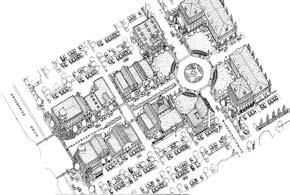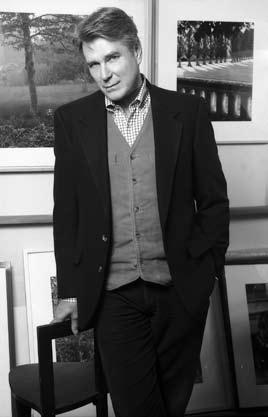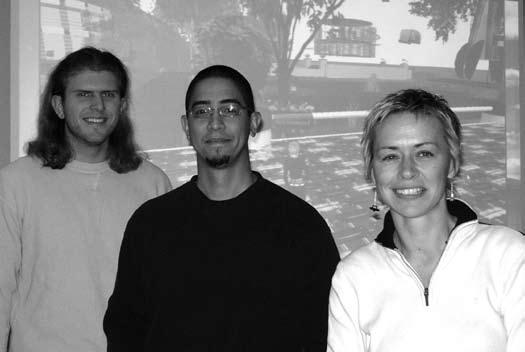
3 minute read
Legacy Connections
Even though their design school experiences were more than two decades apart and in different disciplines, Barry Carpenter (BLA 1972) and his daughter Cara Carpenter (BGD 1996) share similar memories about the College ofDesign. Barry says that in his day, the critiques in the Rotunda were merciless. “You were luckyiftheysaidanythingnice. Goingfirstwas notgoodbecause the professors were pumpedup to reallycritiqueyou, andifyouwentlast, the previous ‘all-nighter’ made youtoo tiredto be effective inpresentation. Theyoperatedonthe weeding-out methodofdesign—aftertwo years ofthis kindofthing, onlythe students who cared aboutdesignwantedto hanginthere andmake itacareer,” he laughs. “Bythe third year you had to know your stuff. You had to think on your feet, and by that time they knewthatdesignwas inyourblood,” he adds. The best thing about his experience was the basic design curriculum ofthe first two years; to him it was “mind-blowing” especially for a self-described “kid from a cotton mill town.” “The most valuable knowledge that I gained was that ofthe design process; it’s the glue that holds everything else together and allows you to be creative within boundaries,” says Barry. “It is the combination ofcreativity, process and a love ofdesign that makes the work rewarding and fun.” Designseems to runinCara’s family. Inaddition to herfatherbeingalandscape architect, hermother’s grandfatherwas RaleigharchitectJames MatthewKennedy. He studiedtextiles atNCState whenitwas stillcalledNorthCarolinaCollege of Agriculture andMechanicArts, andhe designedRaleigh’s CityMarketandMurphey School. What’s more, herbrotheris apotterinAsheville. Growing up in Raleigh, Cara spent many a weekend at the then-called School ofDesign drawing on studio chalkboards and playing at the Egg. When it came time for her to apply to colleges, she was undecided. “I didn’t have a vocabulary to describe what I thought I wanted to do,” she says. “I liked color and making things ‘essentially design’ but without any art experience in high school, I was having a difficult time verbalizing my thoughts and figuring it out. My dad helped me formalize what I was thinking about into something that I could do with my life.” Once she discovered graphic design (with much credit given to an open house presentation by Meredith Davis), she was hooked. At the School ofDesign, Cara took in everything. She explains that even

Advertisement
though she was using computers and her father’s medium in school was drawing, the design process they learned was fundamentally the same, and to this daythat shared experience gives them a strong foundation for talking about design. Barrysays that“the ‘legacyfactor’ does help buildafoundationforthe children ofdesigners,” and Cara adds that she can’t imagine not having someone like her dadto talkwithaboutdesign. “He was agreatresource forme whenI was inschool. After a crit—good or bad—it was nice to have someone to share it with, someone who understood! I still relyon mytalks with him.” It’s hard for her to imagine how herdadmusthave feltreturninghome to Gastoniaforbreaks andnothavinganyone to talkwith about this great thing called design. “I feel veryfortunate to have had the benefit ofmydad’s experience, otherwise I might not have ever discovered this profession that is so important to me. It’s bigger than a profession—it’s mylife.” Barry is quick to add that he believes that “NC State was a good place for Cara, providing her with a strong design education.” After graduation, theyboth worked for professional firms, and nowtheyeach havetheirowndesignbusinesses. Barryand his wife Phoebe Kilby started Sympoetica in1986. Sympoeticafocuses oncommunity planning and design, making places where people wantto live, workandenjoylife. Cara went into business for herselfin 2006 with the openingofStudio Pragmatikin Chicago. Studio Pragmatikis agraphicdesignfirm that develops identity, collateral, andotherprojects for organizations including Fortune 500 companies and small businesses. Father and daughter have collaborated on projects together. Last year they developed placemaking streetscape banners for the City ofLynchburg, Virginia. “The client loved it, and I enjoyed working with her,” says Barry. If you are have a legacy connection, please E-mail design@ncsu.edu with details. Top: Cara Carpenter–UA Today, United Airlines employee publication; Bottom: Barry Carpenter–Wyndhurst, bird's eye view of the town center










